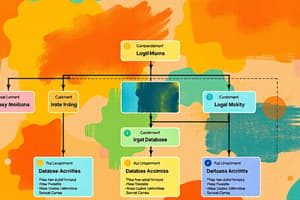Podcast
Questions and Answers
What is one advantage of obtaining information systems (IS) in-house?
What is one advantage of obtaining information systems (IS) in-house?
- Lower initial costs
- Flexibility to customize software (correct)
- Less reliance on internal staff
- Immediate market availability
What does the process of weighted scoring help with during vendor selection?
What does the process of weighted scoring help with during vendor selection?
- Prioritizing vendor criteria objectively (correct)
- Developing a more comprehensive RFP
- Simplifying financial analysis
- Accelerating the decision-making process
Which of the following is a common risk associated with in-house IS development?
Which of the following is a common risk associated with in-house IS development?
- Higher quality assurance
- Enhanced user collaboration
- Insufficient planning (correct)
- Hastened software deployment
Which of the following is a potential drawback of outsourcing the development of information systems?
Which of the following is a potential drawback of outsourcing the development of information systems?
What is one method mentioned for evaluating vendors during the purchase process?
What is one method mentioned for evaluating vendors during the purchase process?
What is one key element that companies should consider when outsourcing IS development?
What is one key element that companies should consider when outsourcing IS development?
Who typically helps contribute to in-house software development according to the content?
Who typically helps contribute to in-house software development according to the content?
What is a significant complexity that can arise when developing in-house information systems?
What is a significant complexity that can arise when developing in-house information systems?
What is one challenge companies face when developing an AIS internally?
What is one challenge companies face when developing an AIS internally?
Which of the following is a step in the purchasing process for an information system?
Which of the following is a step in the purchasing process for an information system?
What is a potential drawback of using canned software?
What is a potential drawback of using canned software?
What is one common reason organizations choose to outsource their information systems?
What is one common reason organizations choose to outsource their information systems?
What is a necessary step before selecting a vendor for an information system?
What is a necessary step before selecting a vendor for an information system?
Why can changes to an AIS be difficult once specifications are written?
Why can changes to an AIS be difficult once specifications are written?
What does 'inhouse' refer to in the context of obtaining information systems?
What does 'inhouse' refer to in the context of obtaining information systems?
What can lead to the failure of a newly designed system meeting user needs?
What can lead to the failure of a newly designed system meeting user needs?
Which of the following is a potential benefit of outsourcing information systems?
Which of the following is a potential benefit of outsourcing information systems?
What is one potential downside of using vendor-supplied canned software?
What is one potential downside of using vendor-supplied canned software?
What is one of the primary benefits of obtaining IS through in-house development?
What is one of the primary benefits of obtaining IS through in-house development?
Which of the following is considered a risk of in-house IS development?
Which of the following is considered a risk of in-house IS development?
What advantage does outsourcing provide to companies?
What advantage does outsourcing provide to companies?
Which of the following is a disadvantage associated with outsourcing?
Which of the following is a disadvantage associated with outsourcing?
Which type of candidates are most suitable for outsourcing?
Which type of candidates are most suitable for outsourcing?
What potential negative outcome can result from outsourcing?
What potential negative outcome can result from outsourcing?
How can outsourcing affect a company's competitive advantage?
How can outsourcing affect a company's competitive advantage?
What is a recent trend regarding outsourcing mentioned in the content?
What is a recent trend regarding outsourcing mentioned in the content?
Flashcards
Obtaining Information Systems
Obtaining Information Systems
Acquiring a computer system for business functions, involving buying, building in-house, or outsourcing.
Purchasing an IS
Purchasing an IS
Selecting and buying application software, vendor services, and hardware from an external provider.
In-house development
In-house development
Building an information system software internally within the organization.
Outsourcing
Outsourcing
Signup and view all the flashcards
Canned Software
Canned Software
Signup and view all the flashcards
Request for Proposal (RFP)
Request for Proposal (RFP)
Signup and view all the flashcards
Vendor Selection
Vendor Selection
Signup and view all the flashcards
Software Upgrade Challenges
Software Upgrade Challenges
Signup and view all the flashcards
Internal Development Difficulties
Internal Development Difficulties
Signup and view all the flashcards
User Needs Specification
User Needs Specification
Signup and view all the flashcards
Vendor Selection Process
Vendor Selection Process
Signup and view all the flashcards
In-house IS development Risks
In-house IS development Risks
Signup and view all the flashcards
End-user Computing (EUC)
End-user Computing (EUC)
Signup and view all the flashcards
RFP/RFI
RFP/RFI
Signup and view all the flashcards
Weighted Scoring
Weighted Scoring
Signup and view all the flashcards
Benchmarking
Benchmarking
Signup and view all the flashcards
Outsourcing IS - Benefits
Outsourcing IS - Benefits
Signup and view all the flashcards
Outsourcing IS - Disadvantages
Outsourcing IS - Disadvantages
Signup and view all the flashcards
In-house IS Benefits
In-house IS Benefits
Signup and view all the flashcards
In-house IS Risks
In-house IS Risks
Signup and view all the flashcards
Outsourcing Candidates
Outsourcing Candidates
Signup and view all the flashcards
In-house IS
In-house IS
Signup and view all the flashcards
Purchase IS
Purchase IS
Signup and view all the flashcards
Study Notes
AIS Development Strategies
- Organizations acquire application software, vendor services, and hardware in various ways.
- Information system departments develop custom software.
- End-users develop, control, and use computer-based information systems.
- Organizations outsource their information systems to evaluate benefits and risks.
Introduction
- Companies face difficulties in developing AIS internally, including resource backlogs, slow processes, unmet user needs, and difficulty adjusting to changes after specifications are set.
Obtaining an Information System (IS)
- Three ways to obtain IS: Purchase, In-house development, Outsourcing.
Purchase
- How to Purchase:
- Select vendors (referrals, trade shows).
- Request for proposal (RFP) to meet needs.
- Evaluate proposals and vendor demonstrations to fit needs and criterion.
- Canned Software Considerations:
- Canned software often pre-built systems sold on the open market to users with similar needs.
- Difficulties can include difficulty in meeting specific needs, frequent upgrades needed, and loss of control due to vendor dependency.
- Personal experience with specific canned software mentioned (UBS, Mr. Accounting, Coda Financials, MySoft, MYOB, QuickBooks).
In-House Development
- How to Obtain an In-House System:
- Internal IT or IS departments handle entire development.
- End-users can also develop systems. (EUC)
- Advantages:
- Increased control, customization potential
- Disadvantages:
- Significant time and resources required, potential difficulties in meeting specific needs, coordination issues, and risk for poor planning.
Outsourcing
- Outsourcing Candidates:
- Non-critical systems, non-core processes
- Non-intellectual property-related tasks
- Operational maintenance
- Recent Trends: Entire work or core functions are often outsourced.
- Advantages:
- Focus on core competencies, reduced time, cost efficiency.
- Disadvantages:
- Loss of control, security risks, potential difficulty in coordination, and inflexibility.
Class Activity Questions
- What is an accountant's role in the computer acquisition process? An accounting professional's involvement includes analyzing financial implications, return on investment, and software costs.
- What are the benefits of analyzing the operating environment before selecting the software? Proper analysis identifies necessary and sufficient software features to meet user and technical requirements.
- What are the primary components of an RFP? RFP typically addresses detailed requirements for the system, including hardware-software needs, pricing details, and testing protocols.
- Explain End-User-Developed Software. End-user developed software, or EUC, involves end-users designing and implementing portions of the information system.
- What are the benefits of outsourcing? Outsourcing has potential benefits like cost savings, efficiency improvements, and access to specialized expertise.
Studying That Suits You
Use AI to generate personalized quizzes and flashcards to suit your learning preferences.




